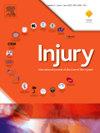在严重创伤系统中,自我导向的暴力和不明确的意图表现。多站点分析。
IF 2.2
3区 医学
Q3 CRITICAL CARE MEDICINE
Injury-International Journal of the Care of the Injured
Pub Date : 2025-02-01
DOI:10.1016/j.injury.2025.112156
引用次数: 0
摘要
背景:对于创伤临床医生来说,确定创伤是一种自我导向的暴力行为(SDV)还是来自高风险或不明确的行为是一项挑战,可能受到患者性别和损伤机制的影响。本研究的目的是研究在区域创伤系统中,故意对自己实施暴力的人与意图不明确的人在特征和结果上的差异。方法:在2018年1月至2021年12月期间收集数据,这些患者被确定为自我导向暴力(SDV)的结果,SDV定义为任何可能导致自我伤害的故意行为,包括死亡或参与意图不明确的高风险行为(UI)。探讨以SDV和意图不清为表现的女性和男性患者的差异。结果:总体而言,2760例患者被确定,中位年龄为39岁(IQR 28-54),超过四分之一的女性(28%)。从高处坠落是所有组中最常见的损伤机制。45%的患者记录了SDV,与那些意图不明确的患者相比,这一组先前的精神健康诊断几乎是其流行率的三倍(SDV: 42% vs UI: 13%)。在基于性别的分析中,女性比男性更有可能有抑郁史(49%比31%,p < 0.0001)。SDV组的性别差异不大,但意图不明确的女性年龄较大,其中四分之一的年龄在65岁或以上(女性:26%,男性:11%,p < 0.0001)。意图不明确的女性也更有可能持续高水平跌倒(女性:29%,男性:11%,p < 0.001)。结论:在我们的队列中,先前的精神健康合并症与自我导向暴力有关。然而,半数以上患者的意图决定因素并不清楚。创伤临床医生应积极询问有关伤害的意图,并根据指示升级到临床心理学或精神病学小组。那些有精神疾病合并症的人、既往的抑郁症患者和老年妇女在意图不明确的情况下都可能有更高的风险,需要进一步调查。了解不明确意图和高危行为的预测因素和特征,是围绕预防自我导向暴力和自杀实施公共卫生战略的关键。本文章由计算机程序翻译,如有差异,请以英文原文为准。
Self-directed violence and unclear intent presentation within a major trauma system. A multisite analysis
Background
Determining trauma as an act of Self-directed violence (SDV) or from high risk or unclear behaviours is challenging for trauma clinicians and may be affected by patient sex and mechanism of injury. The aim of this study was to examine the differences in characteristics and outcomes between those who have intentionally directed violence towards themselves with those of unclear intent, within a regional trauma system.
Methods
Data was collected between January 2018 and December 2021 in patients who had been identified as a result of either self-directed violence (SDV) defined as any intentional act that can cause injury to one's self, including death or participated in high-risk behaviours, where the intent was unclear (UI). Differences between female and male patients presenting with SDV and unclear intent were explored.
Results
Overall, 2760 patients were identified, with a median age of 39 years (IQR 28-54) and just over a quarter of females (28 %). Falls from height were the most common mechanism of injury in all groups. SDV was recorded in 45 % of patients, and previous mental health diagnoses were almost three times as prevalent in this group compared to those of unclear intent (SDV: 42 % vs UI: 13 %). In the sex-based analysis females were more likely than males to have a history of depression (49 % vs 31 %, p < 0.0001). There were few sex differences in the SDV group but women of unclear intent were older, with a quarter being aged 65 years or over (Females: 26 % vs. Males: 11 %, p < 0.0001). Females of unclear intent were also more likely to have sustained a high level fall (Females: 29 % vs. Males:11 %, p < 0.001).
Conclusion
Previous mental health co-morbidity was associated with self-directed violence in our cohort. Yet the determinants of intent for over half of the patients were unclear. Trauma clinicians should actively enquire regarding intent of injury and escalate to clinical psychology or psychiatry teams as indicated. Those with mental health comorbidities, previous depression and older women may all have an increased risk where intent is unclear and warrants further investigation. Understanding the predictors and characteristics of unclear intent and high-risk behaviours are key to implementation of public health strategies around prevention of self-directed violence and suicide.
求助全文
通过发布文献求助,成功后即可免费获取论文全文。
去求助
来源期刊
CiteScore
4.00
自引率
8.00%
发文量
699
审稿时长
96 days
期刊介绍:
Injury was founded in 1969 and is an international journal dealing with all aspects of trauma care and accident surgery. Our primary aim is to facilitate the exchange of ideas, techniques and information among all members of the trauma team.

 求助内容:
求助内容: 应助结果提醒方式:
应助结果提醒方式:


